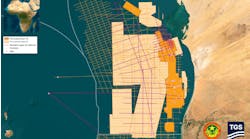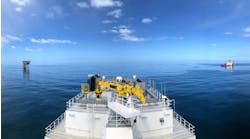Subsequent to the completion of drilling the exploratory well on the Neptune structure (Vioska Knoll 825/865) in the Gulf of Mexico, BP/BHP let a contract with Western Geophysical to acquire a proprietary 3D survey over about 30 Gulf of Mexico blocks (23 sq km/block) surrounding the Neptune structure. Seismic acquisition took place between January and April of 1996.
Planning for this survey took place in late 1995, with the basic acquisition and conventional processing parameters selected by reviewing existing 1994 2D proprietary and older spec data. Some of the impediments to good seismic quality in the area are:
- Rapidly varying water bottom
- Steep dips at the target
- Poorly imaged subsalt data.
BP/BHP used 2D prestack depth migration (PreSDM) and 3D raytracing to determine shooting orientation, migration aperture halo, and optimum offset ranges necessary to image properly both the subsalt and outside-of-salt portions of the structure. As a result of these studies, BP, BHP, and Western Geophysical acquired the new 3D survey with a 6-km maximum offset, a 12-km migration aperture, and with a NW-SE orientation.
During the 2D PreSDM, BP and BHP discovered that the shallow sediment velocity field was much more complex than anticipated. Shallow anomalies and the complexity of the salt bodies largely ruled out 2D data processing methods. To define the structure's size and shape prior to any further drilling, 3D PreSDM was necessary.
The desire of BP and BHP to drill a second well on the structure in mid-1997, plus the need for 3D PreSDM imaging, presented us with very little time to produce a product of sufficient quality to meet interpretation requirements.
Process flow
Because we needed to fast track the 3D PreSDM, an alternative to the traditional flow of time migration followed by depth migration was necessary. The flow chart is divided into four major activities: traditional time processing at the bottom, sediment velocity model building at top left, salt shape definition top center, and depth migration top right. All of these activities were carried out concurrently (see accompanying chart). Contrast this simultaneous use of processing steps with a more traditional approach where the time processing is first completed and interpreted prior to starting a depth migration project. Specific shortcuts used in the processing included:
- Deriving initial sediment velocities without DMO (dip move-out)
- Using near-trace, 1/3-cable migrated stacks without DMO for top salt interpretation
- Allocating data processing and interpretation time for only one iteration of sediment-velocity model building.
In addition, we relied upon just-in-time delivery of intermediate products. For example, the full-fold DMO stack with signal-to-noise ratios better than originally available was needed to pick the base salt.
We identified potential risks in delivery and quality of product to the success of the project. These included poor signal-to-noise ratios for the 1/3-cable stack, mis-positioning due to using data that had not been processed with DMO and DMO velocities, and errors in the sediment velocities due to only a single iteration in updating.
With assistance from an outside consultant, members of all three companies worked together in producing a final plan to achieve the desired results in the required time frame. Risks to the timely delivery and quality of the product were discussed and all shortcuts proposed in the flow were analyzed for their potential impact on the final result. Time savings were realized through both technical shortcuts and streamlined working practices.
A project team was formed that included experienced seismic processors, researchers, analysts, velocity modelers, interpreters, geo logists, and management from all three com panies. BP, BHP, and Western Geophysical interpreters worked together to produce one salt interpretation for input into the velocity model.
A "core" leadership team, with technical and management representatives from each company, was charged with managing the project on a weekly basis. Having a core team allowed necessary changes in the flow to be approved and instituted without delay. In choosing this path, the three companies recognized that some compromise in the quality of the final result would be necessary, but decided that if specific quality standards could be achieved, the results would be worthwhile.
Velocity model building
The initial sediment velocity model was built by Western Geophysical using and improving techniques that were successful on previous projects. The input to this model was from a preliminary set of stacking velocities that did not have DMO applied. Because of the steep dips, we needed to correct the velocities for dip effects. In addition, some targeted DMO velocity analyses were run to confirm the corrections.
Once this sediment model was built, we output 3D PreSDM full offset gathers on a one-mile grid for quality control of our model. With these gathers, we were able to determine where major residual moveout problems existed. We also produced a 3D poststack depth-migrated (PoSDM) volume using the same sediment velocity field. The input stack for this migration used only the traces from the near 1/3 of the cable.
In less complex areas, we followed the migration with an update consisting of depth-to-time conversion, inverse move-out, standard velocity analysis, and time-to-depth conversion of the updated field.
By integrating the move-out picks with the interpretation of the PoSDM, we determined the extent of the lateral velocity anomalies in the shallow section. This information allowed us to adjust the velocities to represent shallow anomalies appropriately.
We modeled these anomalies to determine how important they might be to the final image, since we hoped they might be insignificant compared to errors in the salt geometry. Maximum errors modeled were lateral shifts of 250 meters and depth shifts of 400 meters.
These potential errors were large enough to disrupt the image of the structure. Because the anomalies were large enough to influence the salt geometry, we tried to correct for them in our final sediment model.
Once the model was rebuilt, we re-ran the 3D PreSDM gathers and the 3D PoSDM. The new migration (see accompanying figure) clearly has a better-defined top salt reflector that is now a single-peak event compared to the split doublet with trough seen before the updates. In addition, the section above and to the right of the crestal salt is much more focused, resulting in stronger, more interpretable events.
We were now satisfied that the model was good enough to flatten the data over approximately 70% of the migration output area in one iteration of velocity analysis. We then began to construct the salt model, using the established top salt picking and "salt flooding" approach described by various authors over the years. Revisions were made and the top salt horizon was used to create a "salt flood" model.
At this time, the DMO stacks became available from the time processing. We used them in the salt flood migration because they were stacked with more accurate velocities and had much better signal-to-noise ratios than those that did not include DMO.
The base salt was picked from this migration by the joint BP/BHP/Western team. We produced the final model by merging the top salt and base salt maps. Final 3D PoSDM was completed and available for interpretation before the final 3D time migration was received.
3D prestack depth migration
With the final velocity model, we produced 3D PreSDM's of selected target lines. Through the parallel use of 2D PreSDMs and the velocity model building stage, we were able to optimize the parameter selections. This enabled us to obtain and deliver good-quality sections in a timely fashion. The first target line was output less than six months after the end of the acquisition.
Once the target-oriented 3D PreSDM lines were completed, we were able to judge their quality as compared with the earlier poststack migrations. The PreSDM data were found to be unsatisfactory in areas of steep dip imaging and resulted in some rewriting of the travel time and migration code to handle very steep dips on all offsets. Using this new code, we reran several target lines: these showed considerable improvements.
It is very difficult to interpret subsalt in a 3D poststack time-migrated volume. We can also see that the salt body shape is also severely mispositioned, both laterally and in depth. The 3D PreSDM result is better focused throughout the section. We have much more confidence in the salt shape.
BP/BHP selected an area for full-volume 3D PreSDM to tie the existing well with likely locations for a future well. Through further optimization of parameter choices, we were able to take delivery of an initial 1-1/2 Gulf of Mexico block volume by year-end, with final delivery of six blocks in February, 1997.
Conclusions
This project demonstrated the potential of a well-focused and committed team working on a complex project. Key success factors included a team-building exercise at the beginning of the project that enabled all involved to have a shared commitment with both the process and the outcome. Joint interpretation by BP/BHP/ Western with a multidisciplinary review team enabled us to have a single agreed-upon dataset that included input from many different areas of expertise such as structural geology and migration algorithm development.
In addition, the depth-migrated data were better quality for defining the salt shape, subsalt reflections, and for imaging the steeper dips outside of the salt areas. Having depth-migrated data before time-migrated data led us to ask whether we need time-migrated data in the future.
BP and BHP prospect teams took delivery of 31 targeted PreSDM lines in October 1996. Six Gulf of Mexico blocks of full-volume 3D PreSDM data were delivered in February 1997, less than 10 months after the 3D acquisition was complete. The team's commitment to the processes has allowed us to continue working together on optimizing data quality, both in the Neptune area and on similar structures along strike from the Neptune structure.
Acknowledgment
The authors would like to thank BP Exploration & Oil Inc., BHP Petroleum (Americas) Inc., and Baker Hughes Incorporated for permission to publish. Thanks also to team members Steve O'Hara, Roger Reagan, Chris Travis, Steve Hall, Julie D'Ablaing, George Coltrin, Roland Chen, Kerry Inman, all of BP, Mike Moore, LaRay Geist, Julye Nugent, Tom Leary, Gary Grubitz, all of BHP, Judy Adams, Steve Trares, Connie Gough, Barbara Curd, John Jacka, Uwe Albertin, Wenfong Chang, and Patrick Ng, all of Western. Management sponsors were Steve Peacock (BP), Bernie Wirth (BHP), and Denby Auble (Western). A previous version of this article (OTC No. 10842) was presented at the 1999 Offshore Technology Conference and is presented here with permission.
References
Albertin, U., Kapoor, S., Chang, W., Purnell, N., Leary, T., 1997, "Optimization of steep dip subsalt imaging," Expanded Abstracts, Soc. Expl. Geophys. 67th Ann. Internat. Mtg.
Chen, R., Ekstrand, E., Summers, T., 1997, "Practical application of 3-D depth imaging in the deep water GOM - A case study in the greater Mickey Area, Mississippi Canyon," Expanded Abstracts, Soc. Expl. Geophys. 67th Ann. Internat. Mtg.
Purnell, N., Inman, K., Leary, T., Grubitz, G., Albertin, U., Kapoor, S., and Chang, W., 1997, "Fast track 3-D prestack depth migration of the Neptune structure, offshore Gulf of Mexico," Expanded Abstracts, Soc. Expl. Geophys. 67th Ann. Internat. Mtg.


